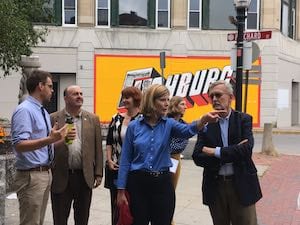Who is a member?
Our members are the local governments of Massachusetts and their elected and appointed leadership.

Representatives from Smart Growth America tour downtown Fitchburg with local officials.
Fitchburg has received a detailed report on how to revitalize its downtown using best practices and taking advantage of existing amenities, while using economic data to buttress its recommendations, thanks to the nonprofit advocacy group Smart Growth America.
Tom Skwierawski, the city’s executive director of community development, said many of the recommendations in the report parallel ideas that the city discussed as part of its master planning and in the economic development strategy development process it’s undertaking now with The Collins Center for Public Management at UMass Boston.
He said, however, that Smart Growth America’s “hotspot” analysis of property values and land use, and the perspective of an outside organization, support and revitalize those ideas, while reminding the city of the assets it already has.
“Maybe we sort of forget the aspects that are right in front of us – the things they noticed as an outsider that are so critical to our identity as a city that we can often brush them aside,” Skwierawski said.
Mayor Stephen DiNatale echoed this sentiment.
“They really pointed out the importance of exploiting – and I mean that in a positive way – the Nashua River, and some of the approaches we could explore that would increase our regional visibility in ways we could market the city, not to mention the importance of the natural resources,” DiNatale said.
The Smart Growth America team’s two-day visit last fall began with a tour of the city’s downtown. During the second day, the team held a workshop with about 30 public officials, private companies and nonprofits, which broke into groups to help develop a set of strategies for various downtown districts. These ideas, and collaboration with Skwierawski and Fitchburg Economic Development Director Mary Jo Bohart, contributed to the final report, released in January.
The team also spoke at a City Council meeting, where they laid out the economics of downtown revitalization using their hotspot analyses and taking into account the ability of existing infrastructure to support growth.
The team made the case that the most economically efficient investments are made in tighter, denser urban places, Skwierawski said.
“Of course that’s something where our city councillors’ ears perked up,” he said. “It helped them understand not just the symbolic importance of investing in our downtown, and importance in terms of sustainability, but that this is a dollars and cents argument and will help us balance our books in the future.”
DiNatale said the Smart Growth America team also put downtown development, in Fitchburg and nationally, in historical context.
“They pointed out issues that, quite frankly, I wasn’t aware of, that movement back in the 1970s away from Main Streets,” he said. “People [now] want that walkability, that placemaking component to downtowns. We have a prime example of something that would thrive with that approach – reuse of historic buildings and a focus on circulation within the city center and the neighborhoods that join it.”
Fitchburg was one of six communities in the nation to receive the particular technical assistance grant from Smart Growth America. Leading the group were John Robert Smith, a former mayor of Meridian, Miss., and a policy advisor for Smart Growth America, and Christopher Zimmerman, Smart Growth America’s vice president for economic development.